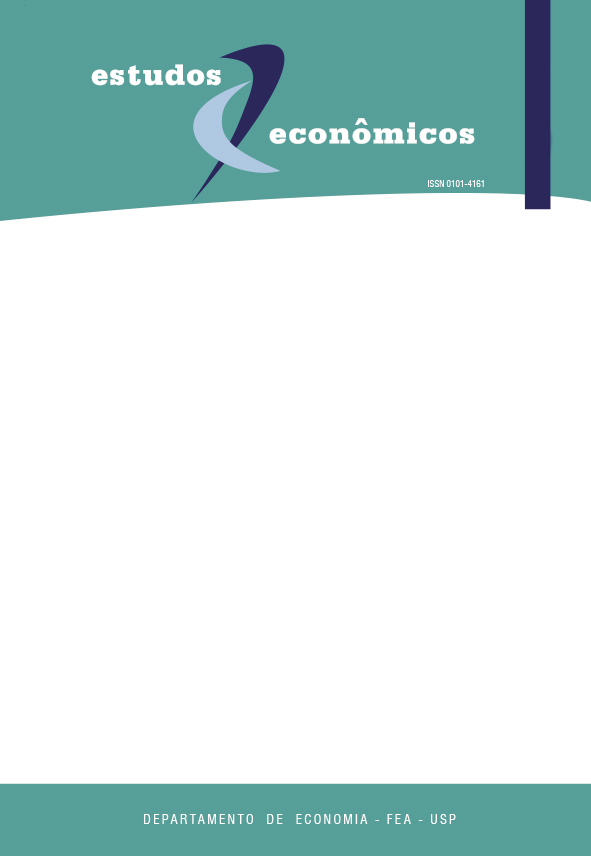Renda básica da cidadania versus imposto de renda negativo: o papel dos custos de focalização
DOI:
https://doi.org/10.1590/S0101-41612008000300006Keywords:
basic income, poverty, computable general equilibrium modelAbstract
This paper compare two alternative social politics to reduce poverty and income inequality in Brazil. The first one is a payment of a universal fixed income, called Basic Income Grant (BIG), and the second one is a Negative Income Tax (NIT), pay only to the families with low incomes. For analysis, we use a Computable General Equilibrium Model. The results had shown that the BIG is better that NIT when the costs of administration associated with the NIT is higher than 50%, and that for a cost between 0 and 50% the adopted program goes to depend on the strategy of poverty reduction.Downloads
References
ADELMAN, I.; ROBINSON, S. Income distribution and growth: a case study of Korea. Oxford: Oxford University Press, 1976.
BARROS, R. P.; COURSEIL, C. H.; CURY, S. Salário mínimo e pobreza no Brasil: uma abordagem de equilíbrio geral. Pesquisa e Planejamento Econômico, v. 30, n. 2, p. 157-182, 2000.
Boeters S.; Feil , M.; Gürtrtzgen , N. Discrete working time choice in an Applied General Equlibrium Model. In: ZEW Discussion Paper n. 04-20, 2004.
Bohacek ohacek , R. The efficiency-equality tradeoff in welfare state economies. In: Econ WPA Macroeconomic Series n. 0203001, mar. 2002.
BOURGUIGNON, F.; MELO, J.; SUWA, A. Modelling the effects of adjustment programmes on income distribution. World Development, v. 19, n. 11, p. 1527-1544, 1991.
CURY, S. Modelo de equilíbrio geral para simulação de políticas de distribuição de renda e crescimento no Brasil. 1998. Tese (Doutorado em Economia) – Escola de Administração de Empresas de São Paulo, Fundação Getúlio Vargas. São Paulo.
EISSA, N.; KLEVEN, H. J.; KREINER, C. T. Welfare effects of tax reform, and labor supply at the intensive and extensive margins. In: AGELL, J.; Sørensen , P.B. (eds). Tax policy and labour market performance, Cambridge: MIT Press, forthcoming, 2005.
FOSTER, J.; GREER, J.; THORBECKE, E. A class of decomposable poverty measures. Econometrica, v. 52, n. 3, p.761-766, 1984.
FRIEDMAN, M. Capitalismo e liberdade. Rio de Janeiro: Editora Arte Nova, 1975.
HARBERGER, A. C. Reflections on distributional considerations and the public finances. Paper Prepared For a Course On Practical Issues Of Tax Policy In Developing Countries. The World Bank, 2003.
HENRIQUES, R. (org.). Desigualdade e pobreza no Brasil. Rio de Janeiro: IPEA, 2000.
HOFFMANN, R. Distribuição de renda: medidas de desigualdade e pobreza. São Paulo: Edusp, 1998. 275 p. (Academia, 22).
IBGE. Pesquisa de Orçamentos Familiares 2002/2003. Rio de Janeiro, 2004.
KHAN, H.A. Sectoral growth and poverty: a multiplier decomposition analysis for South Africa. World Development, v. 27, n. 3, p.138-154, 1999.
KLEVEN, H. J., KREINER, C. T. Labor supply behavior and the design of tax and transfer policy. University of Copenhagen Working Paper, 2005.
LAVINAS, L. Combinando compensatório e redistributivo: o desafio das políticas sociais no Brasil. In: Seminário Desigualdade e Pobreza no Brasil, 1999, Rio de Janeiro. Anais. Rio de Janeiro: Coord. Ricardo Henriques, IPEA, 1999.
LINDBECK, A. The swedish experiment. Journal of Economic Literature, v.35, n.3, p.1273–1319, 1997.
MOFFITT, R. A. The negative income tax and the evolution of U.S. welfare policy. Journal of Economic Perspectives, v. 17, n. 3, p. 119–140, 2003.
MULLER, T.; NAGA, R. A.; BAALEN, B.; KOLDZIEJCZYK, C. Economic effects of different proposals for the reform of the social security system in Switzerland. National Research Program 45, 2004.
NERI, M. Mapa do fim da fome 2. FGV/ EPGE, 2001.
PAES, N. L. Reforma tributária: aspectos distributivos e de bem-estar. 2004. Tese (Doutorado em Economia) – Universidade de Brasília – UnB. Brasília.
PAES, N. L; BUGARIN, M. S. Parâmetros tributários brasileiros. Estudos Econômicos, São Paulo, v. 36 n. 4 p. 699-720, out/dez 2006.
PEDERSEN, M. T. Understanding business cycle. Classes Notes, 1999. Disponível em: <http://www.econ.ku.dk/tmp/Understand/understandingbusinesscycles.htm>.
ROCHA, S. Pobreza e desigualdade no Brasil: o esgotamento dos efeitos distributivos do plano real. Rio de Janeiro: IPEA, 2000. (Texto para Discussão, n. 721).
SUPLICY, E. M. Renda básica da cidadania. Porto Alegre: L&PM, 2006.
SUPLICY, E. M. Renda de cidadania - a saída é pela porta. São Paulo: Editora Perseu Abramo, 2002.
Downloads
Published
Issue
Section
License
Copyright (c) 2008 Nelson Leitão Paes, Marcelo Lettieri Siqueira

This work is licensed under a Creative Commons Attribution-NonCommercial 4.0 International License.
By submitting an article, the author authorizes its publication and attests that it has not been submitted to any other journal. The original article is considered final. Articles selected for publication are proofread for grammatical and orthographic errors. The journal does not pay rights for published articles. The Institute of Economic Research from the School of Economics, Business and Accounting of the University of São Paulo (Instituto de Pesquisas Econômicas da Faculdade de Economia, Administração e Contabilidade da Universidade de São Paulo) owns the journal's copyright.




